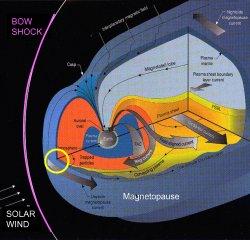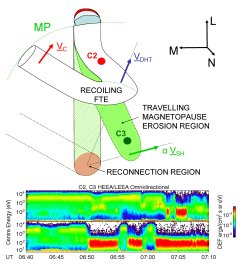
A 3D cut showing regions of the magnetosphere. FTE formation occurs on or near the subsolar magnetopause (yellow circle). Courtesy: TBD
Science Nuggets: Magnetospheric Physics
Discovery of the 'traveling magnetopause erosion region'
Magnetic reconnection governs the coupling between the solar wind and the magnetopshere, determining the structure and dynamics of near-Earth space. However, this is not a steady process but occurs in intermittent episodes known as flux transfer events (FTEs). The mode of reconnection which leads to the formation of FTE's remains the subject of some debate, and we are participating as members of a team of international experts under the auspices of the International Space Science Institute, Bern (Team Homepage) to study these phenomena.
In a recent paper, Owen et al. (2008) reported observations of two 'crater'-like FTEs by the Cluster spacecraft. The observations indicated that the spacecraft furthest from the Earth (C3) transitted out of the magnetosphere following the passage of these two FTEs, whereas the other spacecraft remained inside.

Formation of the Crater FTE and associated 'Travelling Magnetopause Erosion Region' (top) together with the Cluster 2 and 3 PEACE electron data (bottom) on which the interpretaion is based. Adapted from Owen et al. (2008)
Under the observed conditions, reconnected flux tubes created by a transient and localized patch of reconnection located nearer to the subsolar point, will move northward and duskward over Cluster, consistent with observations inside the magnetosphere. The FTE signatures arise from this transient inward motion of reconnection-associated boundary layers over the spacecraft. Owen et al. postulated that the transient relocation of C3 into the magnetosheath is due to a region of eroded magnetic flux, lying in the wake of the recoiling FTE, which itself is driven duskward at some fraction of the magnetosheath flow speed. The FTEs pass northward of C3, but the eroded wake, which we term the 'traveling magnetopause erosion region' (TMER), is located equatorward of the FTEs and moves duskward over C3.
For more details, see:
Owen, C.J., A. Marchaudon, M.W. Dunlop, A.N. Fazakerley, J.-M. Bosqued, J.P. Dewhurst, R.C. Fear, S.A. Fuselier, A. Balogh and H. Réme.Cluster observations of "crater" flux transfer events at the dayside high-latitude magnetopause
J. Geophys. Res., 113, A07S04, doi:10.1029/2007JA012701, (2008). [Online]